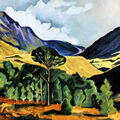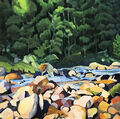Woods of Caledon: the paintings.
These paintings seek to capture the nature and the spirit of Scotland’s Caledonian Forest and in so doing owe a debt to the Brabazon School and the Sois-Bois genre that followed and developed from it through the nineteen and into the twentieth century.
The Barbizon school of painters were part of an art movement, active from c. 1830 through to c. 1870 towards realism in art. It takes its name from the village of Barbizon in France on the edge of the Forest of Fontainebleau. Most of their works were landscape paintings, but several of them also painted genre scenes of village life. Some of the most prominent features of this school are its tonal qualities, colour, loose brushwork, and softness of form.
Rather than painting the scene from afar like traditional landscape painters, the Barbizon artists presented a close-up view of the subject of the painting, recording their experience within the forest and many of the paintings have a portrait (vertical) rather than a landscape (horizontal) orientation. Paintings of this type became known as sous-bois. This French term sous-bois refers to a forest-floor or undergrowth, and to the 19th century painters who cast aside tradition and journeyed into the forests to paint close-up, rather than from a distance.
This approach to painting of woodland and forest subjects was rare before the 19th century, but was adopted and developed by later individual artists and art movements including the impressionists, post impressionists (especially Van Gogh and Cezanne), and the symbolists. Intermittantly it is seen in the works of more modernist painters such as Ivon Hitchens.
To learn more about the Sois-Bois Genre please click on the link below: [link yet to be added]
The oil paintings of Scottish pinewoods in this gallery fall into approximately two groups:
1. largely figuratve impressionist works based on real places, albeit with some latitude for interpretation. These include works that would fall into the Sois- bois category, but also other more conventional landscape works.
2. semi abstract and often expressionist works intended to capture the essence of the forest in some way other than a literal representation. Again some of these works are akin to later symboist, cubist, expressionist and modernist manifestations of the sois-bois genre.
These paintings seek to capture the nature and the spirit of Scotland’s Caledonian Forest and in so doing owe a debt to the Brabazon School and the Sois-Bois genre that followed and developed from it through the nineteen and into the twentieth century.
The Barbizon school of painters were part of an art movement, active from c. 1830 through to c. 1870 towards realism in art. It takes its name from the village of Barbizon in France on the edge of the Forest of Fontainebleau. Most of their works were landscape paintings, but several of them also painted genre scenes of village life. Some of the most prominent features of this school are its tonal qualities, colour, loose brushwork, and softness of form.
Rather than painting the scene from afar like traditional landscape painters, the Barbizon artists presented a close-up view of the subject of the painting, recording their experience within the forest and many of the paintings have a portrait (vertical) rather than a landscape (horizontal) orientation. Paintings of this type became known as sous-bois. This French term sous-bois refers to a forest-floor or undergrowth, and to the 19th century painters who cast aside tradition and journeyed into the forests to paint close-up, rather than from a distance.
This approach to painting of woodland and forest subjects was rare before the 19th century, but was adopted and developed by later individual artists and art movements including the impressionists, post impressionists (especially Van Gogh and Cezanne), and the symbolists. Intermittantly it is seen in the works of more modernist painters such as Ivon Hitchens.
To learn more about the Sois-Bois Genre please click on the link below: [link yet to be added]
The oil paintings of Scottish pinewoods in this gallery fall into approximately two groups:
1. largely figuratve impressionist works based on real places, albeit with some latitude for interpretation. These include works that would fall into the Sois- bois category, but also other more conventional landscape works.
2. semi abstract and often expressionist works intended to capture the essence of the forest in some way other than a literal representation. Again some of these works are akin to later symboist, cubist, expressionist and modernist manifestations of the sois-bois genre.
Pinewood Oil Paintings

10. Slopes of Creag Fhiaclach

1. Banks of the Luineag

16. Pines around Lochan Mors

52. Rothiemurchus sois-bois.

26. Flooded with Light

3. Sunlight on the Forest Floor

2. Alt Rabhaig:

30. Reflections, Loch an Eilean

4. Rothiemurchus Forest.

33. Close by the Cairngorm footbridge

25. Heading into Glen Feshie

13. Glenmore from Loch Morlich.

62. Shallow Roots of the Scots Pine

53. Sunlight and shadow, Abernethy Forest

11. Forest Bog or Muskeg

56. Through the Lairig Ghru to Deeside

32. Group of ancient Pines, Inshriach

23. Estate Cottages

47. Banks of the Allt Druidh

44. Artificial treeline on slopes of Meall a’ Bhuachaille towards the head of the Ryvoan Pass.

28. Headwaters of the Alt Mor

40. Inshriach Forest

69. An old (200+years) “mother tree”

41. The lip of the quarry

7. Ancient Pines near Loch an Eilein

29. The Headwaters of the Allt Mor, 2

67. Pine heath

34. Forest Clearing

35. Light and Shade

57. Path to the Chalamain Gap from above the footbridge

8. Ancient Pines flanking the path above Loch an Eilein

22. Reflections, Loch Garten

42. Regenerating Pines after wartime clearance

6. Ancient Pines in the Ryvoan Pass

5. Mature Pines on the edge of wartime clearance

43. Old Pines at the forest edge

27. Carn Eilrig and the Lairig Ghru

65. Below the Bothy

50. After the Fire, looking west across the Spey to the Monadhliath

51. Abernethy Forest through the Ryvoan Pass, from Airgiod-meall

